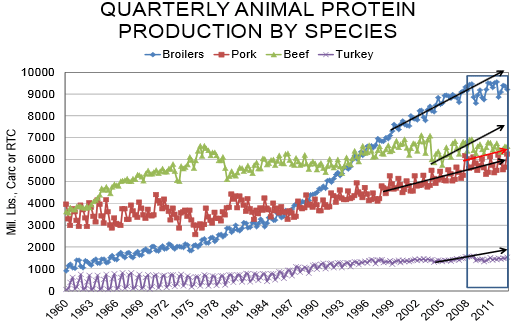



CME: Why Was Pork Production at Record High in Q4 2012?
US - We were recently challenged after a presentation by an attendee who said “If high feed prices are so bad, why was pork production record high in the fourth quarter of 2012?“ That is a legitimate question since a) it is based on fact and b) it correctly points out that warnings of dire reductions in meat protein supplies — including ours! — have not proven accurate, write Steve Meyer and Len Steiner.But the question begs for context. What is the proper yard-stick to measure the impact feed costs increases have had on meat and poultry production? We think the answer lies in comparing trends, not comparing snapshot production levels such as quarterly pork output.
Consider the chart of quarterly meat and poultry output by species below. We have made it larger than our normal page one charts so readers can see details. The black arrows have been inserted to denote the trends that were in place as of Q4-2007 for each species’ quarterly production. All were growing with broiler and beef output increasing by about the same amount per year and pork and turkey out- put growing slower but clearly increasing.

We believe it is no coincidence that all of the trends shifted abruptly at about the beginning of 2008 when corn prices broke through $4.00 per bushel on their way to $7.00-plus that summer. The weekly corn price had eclipsed $4.00 of a few occasions in 2007 but early 2008 marked the first clear surge for prices to levels that have, since 2010, become commonplace.
By the end of 2008, the rate of growth of output for all four major animal protein species has changed dramatically. Chicken output fell sharply in 2008, driven largely by production cutbacks at Pilgrim’s Pride and the company’s eventual bankruptcy. Some have offered that bankruptcy as the reason for the trend change. But we need to remember that financial failure is the mechanism that commodity markets use to force reductions in output. Some firms may reduce output without going bankrupt but it is usually exits – in this case by a major player – that cause the most significant supply reductions.
The observant reader would say “Yes, but pork has recovered to it’s pre-2008 trend line,” and, on its face, that observation is true. But here again, one must consider context. In 2007, the pork industry was the beneficiary of a major technological development in the form of vaccines to control circovirus, a pathogen that had been found to be sort of a gateway for many other swine health problems. The products had a major impact on the number of pigs that made it all the way to market, positively impacting production economics and animal welfare (sort of interesting how those go hand in hand in most cases, is it not?). The result was a surge in pork output in Q4-2007 – a surge that, we think, would have continued had it not been for high feed costs. Therefore, we think the relevant trend for pork production given the continued use of circovirus vaccines would have been the red trend line, not the black trend line that dates back to the mid-1990s.
Based on these cursory analyses, it appears to us that outputs of all the major species would have been significantly higher now had grain costs not been pushed up so abruptly. It wasn’t the $4.00-corn that cause the changes. It was the $6.00 and $7.00 corn that forced a slowdown that has, relative to what the previous trends would have provided, reduced broiler and beef output by roughly one billion pounds per quarter and pork and turkey output by roughly 500 million pounds per quarter. Don’t you think consumers would have been a bit better off had they been afforded the opportunity to buy about eight billion pounds more animal proteins this year?








